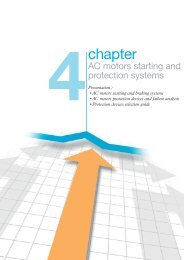Connect - Schneider Electric
Connect - Schneider Electric
Connect - Schneider Electric
You also want an ePaper? Increase the reach of your titles
YUMPU automatically turns print PDFs into web optimized ePapers that Google loves.
1 DESCRIPTION OF THE GROUP, AND ITS STRATEGY, MARKETS AND BUSINESSES<br />
RISK FACTORS<br />
This change will be based on six major areas:<br />
• the functionality of the industrial and logistic process;<br />
• industrial planning;<br />
• reinforcement of skills in the target jobs;<br />
• optimisation of the industrial operation (suppliers, factories,<br />
distribution);<br />
• alignment of the information systems strategy with this<br />
segmentation;<br />
• adaptation of the performance measurement.<br />
<strong>Schneider</strong> <strong>Electric</strong>’s plants and products comply with increasingly<br />
extensive and stringent European regulations and with international<br />
4.4 Global, selective purchasing<br />
Purchases correspond to around 50% of consolidated revenue<br />
and play a crucial role in the Group’s technical and business<br />
performance. The Group has globalised 70% of purchases from<br />
strategic suppliers and aims to increase local sourcing in emerging<br />
markets to more than 50% as part of its programme to re-balance<br />
costs and revenue.<br />
<strong>Schneider</strong> <strong>Electric</strong> primarily purchases raw materials such as silver,<br />
copper, aluminium, steel and plastics, as well as components,<br />
> 5. Risk factors<br />
As described in Chapter 3.10 Corporate Governance, <strong>Schneider</strong><br />
<strong>Electric</strong> regularly analyses the risks and threats it faces, which has<br />
revealed six major risk categories as follows:<br />
• operating risks that also include the « solution» business, supplier<br />
risks and competitive threats;<br />
• industrial and environmental risks that also include risks such as<br />
natural catastrophes and political disturbances;<br />
• computer risks and internet-security threats;<br />
Risk factors related to the Company’s business<br />
The Group operates worldwide, in competitive<br />
and cyclical sectors<br />
The worldwide markets for the Group’s products are competitive<br />
in terms of pricing, product and service quality, development and<br />
introduction time and customer service. The Group faces strong<br />
competitors, some of whom are larger or developing in certain<br />
lower cost countries. It is exposed to fl uctuations in the economic<br />
growth cycle and to the respective levels of investments of the<br />
different countries in which it is present. The Group’s widespread<br />
geographic coverage and diversifi ed end markets enable it to ride<br />
downturns on specifi c markets.<br />
34 2011 REGISTRATION DOCUMENT SCHNEIDER ELECTRIC<br />
standards governing environmental protection in all host countries.<br />
In many cases, the Group anticipates future standards. In 1992,<br />
<strong>Schneider</strong> <strong>Electric</strong> defi ned a formal environmental policy, which was<br />
revised in 2004 to take account of changes both inside and outside<br />
the Group. This policy is designed to improve production processes,<br />
promote eco-design, integrate customer expectations into the<br />
Group’s environmental protection approach and raise awareness<br />
among all employees and partners about environmental protection<br />
and energy effi ciency. In order to limit risks related to the environment<br />
generally, the Group has implemented an ISO 14001-compliant<br />
process to continuously improve the environmental performance of<br />
its plants and supply chain centres.<br />
electronic products and services. The supplier list includes<br />
international fi rms, as well as many small and medium-sized<br />
companies. Suppliers are selected for their know-how, the quality<br />
of their products and services, their competitiveness, their ability to<br />
support the Group’s globalisation approach and their compliance<br />
with environmental and human rights requirements. As a supporter<br />
of the United Nations’ Global Compact, the Group encourages<br />
suppliers to join as well. A sustainable development agreement sets<br />
out each party’s specifi c commitments.<br />
• market risks covering currency risks and commodity price<br />
fl uctuation risks;<br />
• legal risks that also cover intellectual property;<br />
• litigation and related risks.<br />
The Group’s main risks and threats are summaris ed in a chart of<br />
overall risks based on their impact and probability.<br />
As the Group records 39% of its revenue in emerging or developing<br />
countries, it is exposed to the risks associated with those markets.<br />
The Group’s wide international presence exposes it to many<br />
economic, legal and political risks in its host countries.<br />
These include risks arising from social unrest (particularly, strikes<br />
and walk- outs), political instability, unforeseen regulatory changes,<br />
restrictions on capital transfers and other obstacles to free trade,<br />
and local tax laws, all of which may have an adverse effect on the<br />
Group’s business, results of operations or fi nancial position.<br />
<strong>Schneider</strong> <strong>Electric</strong> has implemented procedures designed to<br />
protect it as far as possible from these risks, which are generally<br />
beyond its control, and to manage them as effectively as possible.

















